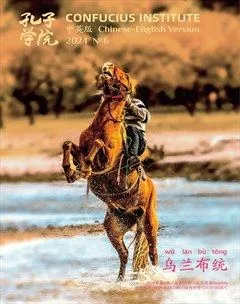草原奶制品
早在千年前,蒙古族人民就与草原为伴,以放牧为生。牛羊是他们最重要的生活来源,而奶制品则是他们每日必吃的家常食品之一。奶制品在蒙古语中为“察干伊德”,意思是白色的食品。
Over a thousand years ago, the Mongolianpeople lived in harmony with the grasslands, relyingon herding for their livelihood. Cattle and sheep weretheir most important resources, and dairy productswere a staple of their daily diet. In Mongolian, dairyproducts are called “tsagaan idee,” which means“white food.”
草原美食——察干伊德
Grassland Delicacies: Tsagaan Idee
草原上最常见的奶制品,是奶皮子和奶酪。蒙古族妇女将新鲜的牛奶倒入锅中,用文火慢慢熬煮,待多次拂扬的热牛奶冒起泡沫后,放凉。放凉后,牛奶表面会结成一种蜂窝状油层,取出晾干后就是奶皮子。它也是制作酥油的原料。剩下的牛奶,继续熬煮,加入适量的酸浆或醋,使凝固成块,再挤压去除水分,经过晾晒,便成了奶酪。这两种简单的奶制品,不仅营养丰富,而且易于保存和携带,是蒙古族人民最常吃的食物。
The most common dairy products on thegrasslands are naipizi (dried milk skin) and cheese.Mongolian women start by pouring fresh milkinto a pot, slowly simmering it over low heat.Once the foam rises to the surface of the boilingmilk, they set it aside to cool. After it cools, it willform a honeycomb-like layer of fat, which is thenremoved and dried to make naipizi. This is also akey ingredient in making butter. The remainingmilk is boiled further and, with the addition of anappropriate amount of whey or vinegar, curdlesinto solid lumps. These curds are then pressed toremove the excess liquid and sun-dried to makecheese. These two simple dairy products are not only highly nutritious, but also easy to store andtransport, making them a staple food for theMongolian people.
奶豆腐是牧民家中另一种常见的奶制品,因形状像豆腐而得名。它是牛、羊、马奶等经凝固、发酵而成的食物,分为生奶豆腐和熟奶豆腐两种。奶豆腐色泽乳白,乳香浓郁,质地柔软细腻,味道有的微酸、有的微甜,十分可口。可直接食用,也可晾干久存。牧民们常泡在奶茶中食用,出远门当干粮,既解渴又充饥。
Milk tofu is another common dairy productfound in herders’ homes. Made from cow’s, sheep’s,or mare’s milk by curdling and fermentation, it getsits name from its resemblance to tofu. There are twotypes: raw and cooked milk tofu. Its color is creamywhite and its taste ranges from mildly sour to slightlysweet, with a rich, milky aroma. Its texture is soft anddelicate, making it very appetizing. Milk tofu can beeaten fresh or dried for long-term storage. Herdersoften soak it in milk tea or take it on long journeys asa dry snack to quench thirst and satisfy hunger.
在草原奶制品中,饮品自然也占据了一席之地,比如蒙古族人日常饮用的奶茶,欢庆节日、款待宾客喝的马奶酒等。据统计,草原人民用牛、羊、马奶制成的各种察干伊德多达几十种。
Among the many dairyproducts of the grasslands,beverages also hold a specialplace, such as the milk teathat Mongolians drink dailyand the airag (fermentedmare’s milk) served atfestivals for guests. In fact,it is estimated that there aredozens of varieties of tsagaanidee made from the milk ofmares, cows, and sheep.
现代味蕾新潮
A Modern Twist on Tradition
元朝时期,蒙古族奶制品已经传入中原地区,成为宫廷贵族餐桌上的美味。到了明朝,内蒙古的奶制品已经名扬四海。据史料记载,清代康熙年间宫廷内有按职位分配乳牛的规定:太皇太后、皇太后各24头,皇帝、皇后共用100头,皇贵妃7头……这反映了奶制品在当时非常珍贵。现在,这些曾经被视为贵族专享的奶制品已经“飞入寻常百姓家”,成为中华美食文化中不可或缺的一部分。
As early as the Yuan Dynasty, Mongolian dairyproducts made their way to central China andbecame a delicacy on the tables of the imperialcourt. By the Ming Dynasty, dairy products fromInner Mongolia had gained national fame. Historicalrecords show that during the Kangxi reign of theQing Dynasty, there were strict regulations on thedistribution of cows within the palace: the GrandEmpress Dowager and the Empress Dowager wereeach given 24 cows, while the Emperor and theEmpress shared 100 cows and the Imperial NobleConsort was given 7 cows, reflecting the high valueplaced on dairy products at the time. Today, theseonce-exclusive delicacies have “flown into the homesof ordinary people” and become an essential part ofChinese culinary culture.
尤其是,随着现代工艺和多元化饮食潮流的融入,内蒙古的奶制品文化也迎来了新的发展机遇,让传统的察干伊德焕发出了新活力。例如,当奶豆腐邂逅都市丽人日常“续命”的咖啡,奶豆腐便拥有了酸甜咸苦的多元时尚风味,而咖啡则浓缩了草原的风味与情调。这种“跨界融合”早就被当代年轻人接受,用奶皮子做的蛋糕、用奶酥做的冰激凌一度成为网红食品。
In particular, with the advent of modernprocessing techniques and diversifying dietarytrends, Inner Mongolia’s dairy culture has embracednew opportunities for growth,NlrvQ3yaqEbPxihyrMEwDw== breathing new life intotraditional tsagaan idee. For example, when milk tofumeets the coffee that city folks rely on to “survive theday,” it takes on a unique blend of sweet, sour, salty,and bitter flavors, while the coffee itself is infusedwith the taste and spirit of the grasslands. This kindof “cross-over fusion” has already been embraced by today’s younger generation.Cakes made with naipiziand ice cream made withmilk butter have evenbecome internet sensations.
随着科技的进步,酿制马奶酒的工艺日益完善,不仅有简单的发酵法,还有新研发的酿制烈性奶酒的蒸馏法,六蒸六酿后的奶酒深受人们的喜爱,并且早已跨越草原,走向更广阔的市场。马奶酒还被都市青年做成了咖啡,甚至还成为调制鸡尾酒的配料。
With advancements in technology, the processof making airag has become increasingly refined.Beyond the simple fermentation method, newdistillation techniques have been developed toproduce stronger milk spirits. The process ofdistilling and brewing six times has created a richflavor that people love, and airag has long sincecrossed the grasslands to reach a broader market.It has even been adapted by urban youth into airagcoffee and incorporated into cocktail ingredients.
内蒙古的奶制品不仅本身丰富多样,还在文化融合和制作工艺发展中绽放出无穷无尽的形态。无论是草原牧民饭桌上的奶豆腐,还是繁华都市咖啡馆里的马奶酒咖啡,都能让人感受到那份源自草原的醇厚与温暖,体验到内蒙古奶制品文化的独特魅力与深远影响。这不仅是一种味蕾的享受,更是一种文化的传承与弘扬。
Inner Mongolia’s dairy products are not onlydiverse in themselves, but they’ve also blossomedinto endless forms through cultural integration andtechnological innovation. Whether it’s the milk tofuon a herder’s table or airag coffee in a bustling citycafe, one can always taste the richness and warmthof the grasslands. It’s a unique experience thatshowcases the charm and lasting influence of InnerMongolia’s dairy culture. This is more than just atreat for the taste buds — it’s a living tradition, passeddown and celebrated through time.

